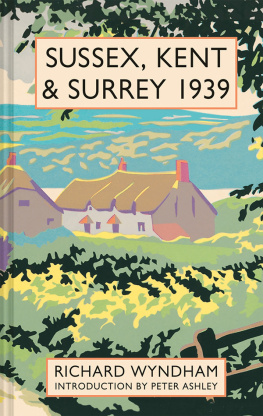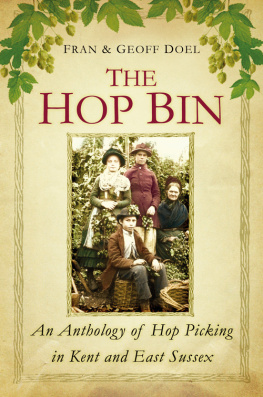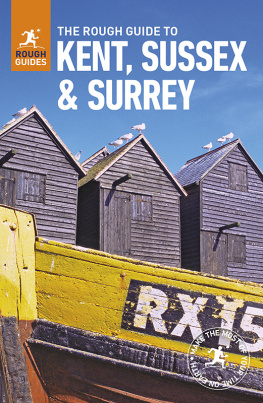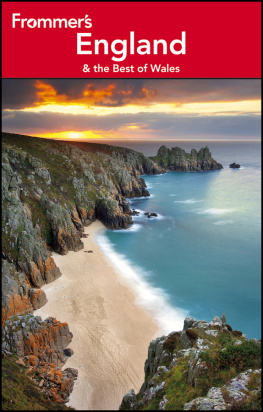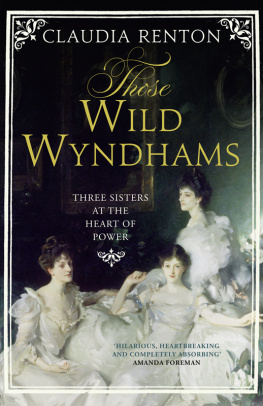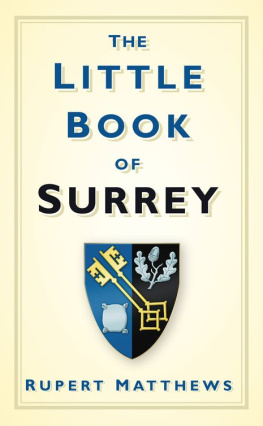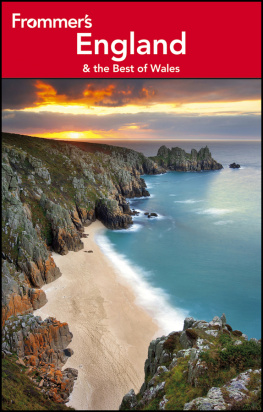Contents
Guide

TO
THE ARM-CHAIR TRAVELLERS
OF THE SECOND GREAT WAR
PUBLISHERS NOTE
T HIS book was almost completed on the outbreak of the war, when the author was called up on active service. Under the circumstances it was impossible for him to complete certain districts, particularly Surrey, as comprehensively as he would have liked, or to make a final check-up on certain references and anecdotes. It was also thought best not to attempt to revise the book in view of recent events, but rather to leave it as it isa nostalgic memory of England in the last months of peace.
November 1939
PREFACE
T HIS is a travel-book rather than a guide-book. I have travelled at haphazard through South-Eastern England; but, for the most part, on side roads only, and through villages and lesser towns. In so short a book it seemed impossible to deal fully with tourists Meccas such as Canterbury, Maidstone, Brighton or Chichester. And the London suburbs would have required a psychological treatise of length. Even with these omissions, my task appeared absurd until I discovered that, while my notes about certain places occupied several pages, about others they remained mere notes. The latter I discarded, and in consequence there must appear an inequality, which is the inequality of my own mind.
In search of my facts, I have picked too many brains to thank the owners individuallyexcept Murray; and in acknowledging a special debt to his Handbooks I am surely voicing the gratitude of most English guide-book authors for nearly a century.
Private houses which are open to the public presented a problem that could only be solved by their omission. To have dealt with them all was impossible; to have selected or criticised would have been an abuse of hospitality.
R. W.
TICKERAGE MILL
August 23, 1939
INTRODUCTION
O NE cold Easter I was writing about the Romney Marsh in Kent, imagining I was out on the windswept pastures and in particular sitting in the white-painted box pews of the tiny church of Fairfield, which sits completely alone two miles south of Appledore. Surrounded by the Marsh sheep and reed-bordered dykes, this is a favourite location with film-makers for its remoteness and atmosphere. I wanted to see how other writers had described this church that served no village but still acted as a focal point for the surrounding farms and cottages. John Newman called it a diminutive, dumpy church set down pat on the marshes, Richard Ingrams thought it looked like a Noahs Ark that has come to rest and Simon Jenkins had it deposited by the tide. It was then that I reached for a book long collected but never read, perhaps subconsciously thinking the title suggested a county council draft plan. It appeared in the Batsford series The Face of Britain: South-Eastern Survey by Richard Wyndham. His Fairfield looks like a toy dropped by a child. I quickly turned to the front of the book and as a result of this playfully apt description, read it cover to cover over what remained of Easter. When I finished I sat and marvelled that this eccentric, eclectic, wry and wonderful tour through the south eastern counties of England, just before the Second World War, had appeared to have been lost in the mists of the eighty years since 1939. It appeared as South East England in 1951 but was needlessly edited. What we see here is the original.
Guy Richard Charles Wyndham was born into the aristocracy in 1896, a descendant of George Wyndham, the third Earl of Egremont who lived at Petworth House in West Sussex. Dick Wyndham, as he was known, was brought up in a Philip Webb designed house, Clouds, in East Knoyle, Wiltshire, later left to him by a cousin. He was educated at Wellington College and at the Royal Military College at Sandhurst and subsequently won the Military Cross in the First World War. In 1927, despite having considerable wealth, he continued his habit of selling a family painting once a year to keep buoyant and sold the 1899 painting of his three aunts (dubbed The Three Graces by the then Prince of Wales) by John Singer Sargent, for 20,000, to the Metropolitan Museum of Art in New York. Around this time he discovered on a walk, and subsequently bought, Tickerage Mill near Uckfield in East Sussex, a property later owned by actress Vivien Leigh. From here he wrote books, painted and made prints, and as Britain prepared for war was asked in 1939 by Batsford to write about his corner of England, a last look round as he described it of Kent, Sussex, and Surrey. In the publishers note you will see that it was almost completed when he was called up on active service. (His daughter Joan, born in East Knoyle in 1927, came to prominence much later with her lively and romantic wartime diaries.) Wyndham was invalided out and became a foreign correspondent for the Sunday Times, but in a skirmish in Jerusalem between Israeli troops and the Arab League he was killed in 1948 by Israeli gunfire as he was taking a photograph of an Arab advance.
Brian Cook, later politician Brian Cook Batsford, illustrated many Batsford dust jackets. When the publisher came to initiating the series The Face of Britain, he hoped that the books would be planned around counties. But Harry Batsford insisted on geographical areas, such as the subsequent Chiltern Country and Cotswold Country. The new series was published alongside the very successful British Heritage books with their brilliantly-coloured jackets by Cook, but instead of the time-consuming Jean Bert printing process his illustrations for The Face of Britain were taken directly from his original paintings by photolithography. And so it was, as Richard Wyndham was finishing his writing and taking up arms, the cover for South-Eastern Survey was being painted. A farm labourer with his cap turned round stands on his empty wagon, giving the horse a rest as he looks over the landscape falling away from him. He sees a patchwork of fields, red-tiled roofs and the distant line of the Downs, whilst his workfellows are finishing loading a cart with hay.
Richard Wyndham wrote his book when already his beloved countryside was threatened by the increase of traffic on arterial roads and over development. The advent of affordable cars meant that Britain was now visited in places that hitherto could only have been reached by the railway, and the new guidebooks like those of Shell and indeed Batsford brought enticing views of British counties. The south east coast could be reached in a couple of hours from London, and Brighton was always an hour from Victoria. The topographical Batsford books of the 1930s almost always used photographs gained from outside sources, but South Eastern Survey exclusively used Wyndhams own images.
When one first opens the book and skims through the pictures, at first glance they may seem just like those in other Batsford books, but on closer inspection many of Wyndhams photographs are very different from anything else in a book of this type at this time. Although the scene probably courted his displeasure, he nevertheless found interest in Whitehawk Camp near Brighton with fences made from discarded iron bedsteads. The ruined farmhouse, sunrise gates and a single decker bus turned into a home in Leysdown on the Isle of Sheppey were unexpected images to see in a Batsford book. These are things some of us clamour to find now, and I wonder whether Richard Wyndham was the first to acknowledge them. He takes the trouble to take his photograph of oast houses in Kent by moonlight, and the backs, not fronts, of Bluecoat boys in Horsham. I suppose its the painters eye, seeing things the casual observer does not. He makes no comment on his photograph of a street in old Folkestone because the indecent plethora of signs says it all, or about the litter left by trippers on Box Hill. I dont know what the make of car is whose bonnet stretches out in his shot of Saltdean, I dont know what camera he used, or what film, but he drove, walked and sat on trains to give us a unique account of the villages, towns and people that were soon to be on the home front line in the Second World War.

